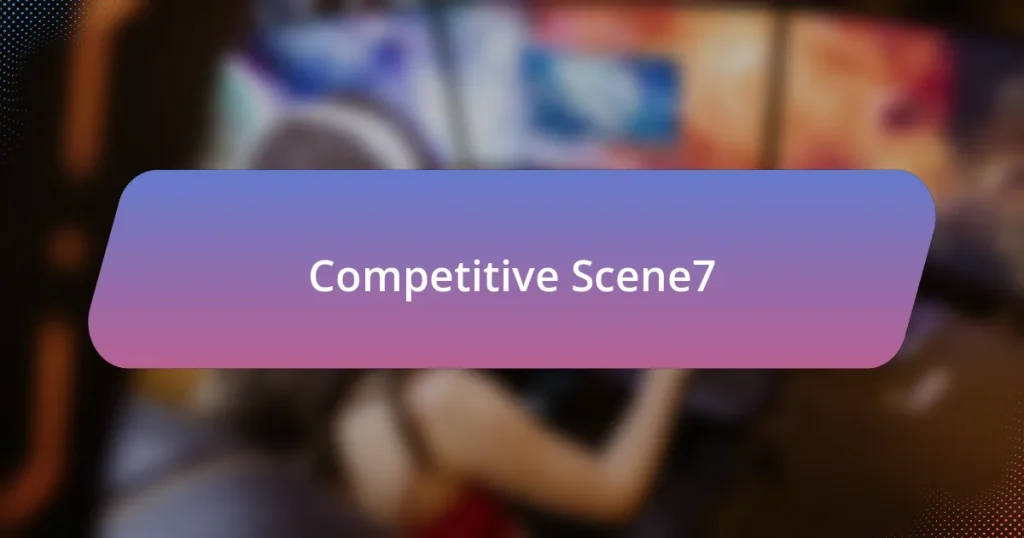Dota 2’s major tournaments, including The International and Dota 2 Major Championships, play a crucial role in the game’s competitive landscape. The article explores the history and evolution of these tournaments, highlighting their significance in the Dota 2 community, the impact on player careers, and the innovations that have emerged over time. Key moments, legendary matches, and the relationship between major tournaments and the Dota Pro Circuit are examined, along with future trends and tips for fans to engage with the competitive scene effectively. This comprehensive overview provides insights into how these tournaments shape the Dota 2 ecosystem and influence the broader esports landscape.

What are the Major Tournaments in Dota 2?
The major tournaments in Dota 2 include The International, Dota 2 Major Championships, and various regional leagues such as the ESL One and DreamLeague. The International, held annually since 2011, is the most prestigious tournament, featuring the highest prize pool, which reached over $40 million in 2021. Dota 2 Major Championships, introduced in 2016, are significant events that contribute to the Dota Pro Circuit, offering teams points to qualify for The International. Regional leagues like ESL One and DreamLeague provide competitive platforms for teams to showcase their skills and earn qualification for larger events.
How did Dota 2’s major tournaments begin?
Dota 2’s major tournaments began with The International, which was first held in 2011. The International was initiated by Valve Corporation to showcase the competitive scene of Dota 2 and featured a prize pool of $1 million, funded through the sale of in-game items. This groundbreaking event set a precedent for future tournaments, establishing a model for competitive gaming that included significant prize pools and international participation, ultimately leading to the growth of Dota 2’s esports ecosystem.
What were the first major tournaments in Dota 2 history?
The first major tournaments in Dota 2 history were The International 2011 and The International 2012. The International 2011 was the inaugural tournament, held at Gamescom in Cologne, Germany, featuring a prize pool of $1 million, which was unprecedented for esports at the time. The International 2012 followed, taking place in Seattle, Washington, and it expanded the prize pool to $1 million again, solidifying its status as a premier event in the Dota 2 competitive scene. These tournaments set the foundation for future Dota 2 competitions and established The International as the flagship event for the game.
How have the formats of these tournaments evolved over time?
The formats of Dota 2’s major tournaments have evolved significantly since the game’s inception. Initially, tournaments primarily featured single-elimination brackets, which limited the number of matches teams could play and increased the impact of a single loss. Over time, the introduction of double-elimination formats allowed teams to have a second chance after a loss, enhancing competitiveness and viewer engagement.
Furthermore, the transition to round-robin formats in group stages has enabled teams to compete against multiple opponents, providing a more comprehensive assessment of their skills. The International, Dota 2’s premier tournament, has also seen changes, such as the introduction of regional qualifiers and a larger pool of participating teams, reflecting the game’s growing global popularity. These changes have been supported by increasing prize pools, which have risen from $1 million in 2011 to over $40 million in 2021, demonstrating the tournament’s evolution and the expanding esports landscape.
What significance do these tournaments hold in the Dota 2 community?
Major tournaments in the Dota 2 community are significant as they serve as the pinnacle of competitive play, showcasing the highest level of skill and strategy among teams. These events, such as The International, not only offer substantial prize pools—often exceeding $40 million—but also foster community engagement and global viewership, with millions tuning in to watch live matches. The tournaments contribute to the game’s ecosystem by providing a platform for players to gain recognition, influence the meta-game, and inspire new strategies, thereby driving the evolution of Dota 2 as a competitive title.
How do major tournaments impact player careers?
Major tournaments significantly impact player careers by providing exposure, financial rewards, and opportunities for skill development. Players who perform well in these high-stakes environments often gain recognition, which can lead to sponsorship deals and invitations to prestigious teams. For instance, winning or placing highly in tournaments like The International can result in substantial prize money, with the 2021 event offering over $40 million in total prizes, thus elevating players’ financial status and career prospects. Additionally, consistent participation in major tournaments allows players to refine their skills against top-tier competition, enhancing their gameplay and marketability in the esports industry.
What role do these tournaments play in the game’s popularity?
Major tournaments significantly enhance Dota 2’s popularity by showcasing high-level competitive play and attracting large audiences. These events, such as The International, generate substantial viewership, with millions of online spectators and significant prize pools, which in 2021 reached over $40 million. This visibility not only engages existing fans but also draws in new players, fostering a larger community. Furthermore, the tournaments create a platform for professional players to gain recognition, which contributes to the game’s cultural relevance and ongoing interest.

What are the Highlights of Dota 2’s Major Tournaments?
The highlights of Dota 2’s major tournaments include significant prize pools, high-profile teams, and memorable matches. For instance, The International, Dota 2’s premier tournament, has consistently featured prize pools exceeding $30 million, with the 2021 edition reaching over $40 million. Major tournaments showcase top teams like Team Secret, OG, and Evil Geniuses, who have made history with their performances. Notably, OG’s back-to-back victories at The International in 2018 and 2019 marked a historic achievement, as they became the first team to win the tournament twice. Additionally, iconic matches, such as the 2016 Grand Finals between Wings Gaming and Digital Chaos, are celebrated for their intense gameplay and strategic depth, further solidifying Dota 2’s status in the esports landscape.
What are some of the most memorable moments in Dota 2 tournament history?
Some of the most memorable moments in Dota 2 tournament history include OG’s victory at The International 2018, where they became the first team to win the tournament after coming through the lower bracket, and the iconic “Bristleback” play by Miracle- during the same event, showcasing exceptional skill. Another significant moment was the 3-2 comeback by Team Liquid against Newbee in The International 2017 finals, which highlighted the intensity and unpredictability of high-stakes matches. Additionally, the “Rampage” by Aui_2000 in the 2015 International, where he single-handedly turned the tide of a game, remains a fan-favorite highlight. These moments are celebrated for their impact on the game’s history and the emotional responses they elicited from fans and players alike.
Which matches are considered legendary and why?
Legendary matches in Dota 2 include the grand finals of The International 2013, where Alliance defeated Natus Vincere, and the epic showdown between Evil Geniuses and CDEC Gaming in The International 2015. These matches are considered legendary due to their high stakes, dramatic gameplay, and significant impact on the esports landscape. The Alliance vs. Na’Vi match showcased a remarkable comeback and strategic depth, while the EG vs. CDEC match featured a thrilling reverse sweep, highlighting the unpredictability and excitement of competitive Dota 2. Both matches are frequently referenced for their intense moments and the skill displayed by the players, solidifying their status in Dota 2 history.
How have player performances shaped tournament narratives?
Player performances have significantly shaped tournament narratives by influencing team dynamics, fan engagement, and overall tournament outcomes. For instance, standout players like Johan “N0tail” Sundstein and Amer “Miracle-” Al-Barkawi have not only led their teams to victory but also created compelling storylines that resonate with fans, such as N0tail’s leadership in OG’s back-to-back TI wins in 2018 and 2019. These performances often dictate the momentum of matches, as seen in the 2016 International where the exceptional play of players like Artour “Arteezy” Babaev and Kuro “KuroKy” Salehi Takhasomi contributed to their teams’ deep runs, thereby enhancing the tournament’s excitement and narrative depth.
What innovations have emerged from Dota 2’s major tournaments?
Innovations from Dota 2’s major tournaments include the introduction of the Battle Pass system, which enhances player engagement through exclusive rewards and content. This system was first implemented during The International 2013, allowing fans to contribute to the prize pool, which has since reached over $40 million in 2021. Additionally, major tournaments have pioneered the use of live streaming technology and interactive viewing experiences, such as the “Watch Together” feature, enabling fans to watch matches simultaneously with friends. These innovations have significantly transformed the esports landscape, making Dota 2 tournaments more accessible and engaging for a global audience.
How have broadcasting and production values changed over the years?
Broadcasting and production values in Dota 2’s major tournaments have significantly improved over the years, evolving from basic live streams to high-quality, multi-camera broadcasts with advanced graphics and professional commentary. Initially, early tournaments featured simple setups with limited camera angles and basic overlays, but as technology advanced, production teams began incorporating high-definition video, real-time statistics, and immersive graphics to enhance viewer engagement. For instance, The International 2018 showcased a production value that included 4K streaming and augmented reality elements, reflecting a trend towards more polished and visually appealing broadcasts. This evolution has been driven by increased investment from sponsors and the growing popularity of esports, leading to a more professional approach in broadcasting Dota 2 tournaments.
What new gameplay strategies have been introduced during these tournaments?
New gameplay strategies introduced during Dota 2 major tournaments include the increased use of unconventional hero picks and the emphasis on early game aggression. Teams have begun to prioritize heroes that can secure early objectives, such as towers and Roshan, leading to a shift in the meta towards faster-paced games. This strategy has been validated by the success of teams that have adopted these tactics, as seen in recent tournaments where early game dominance has often translated into overall victory.

How do Dota 2 Major Tournaments Influence the Competitive Scene?
Dota 2 Major Tournaments significantly influence the competitive scene by establishing a structured environment for teams to showcase their skills and strategies, which in turn shapes the meta-game. These tournaments attract top-tier talent and provide substantial prize pools, incentivizing teams to invest in player development and coaching. For instance, The International, as the pinnacle of Dota 2 competitions, has consistently offered multi-million dollar prize pools, which not only elevates the stakes but also garners global attention, leading to increased viewership and sponsorship opportunities. This heightened visibility encourages emerging teams to compete at higher levels, fostering a more competitive ecosystem. Additionally, the outcomes of these tournaments often dictate shifts in gameplay strategies and hero selections, as teams analyze successful tactics employed by the winners, thereby continuously evolving the competitive landscape.
What is the relationship between major tournaments and the Dota Pro Circuit?
Major tournaments are integral components of the Dota Pro Circuit, serving as key events that contribute to the overall competitive landscape of Dota 2. These tournaments provide teams with opportunities to earn qualification points, which are essential for securing a spot at The International, the premier event in the Dota 2 calendar. The Dota Pro Circuit is structured to include a series of major tournaments, each offering a significant prize pool and ranking points, thereby influencing team standings and their chances of participating in The International. For instance, the Dota Pro Circuit 2021-2022 season featured several major tournaments, such as the Major Championships, which directly impacted team rankings and qualifications for The International 2022.
How do major tournaments affect team rankings and qualifications?
Major tournaments significantly impact team rankings and qualifications by providing crucial points that contribute to a team’s overall standing in competitive play. In Dota 2, for instance, the Dota Pro Circuit (DPC) awards points based on performance in major tournaments, which directly influence a team’s qualification for The International, the game’s premier event. Teams that perform well in these tournaments accumulate higher DPC points, enhancing their chances of qualifying for prestigious events. Historical data shows that teams like OG and Team Secret have leveraged their success in major tournaments to secure top rankings and direct invitations to The International, demonstrating the tangible effects of tournament performance on rankings and qualifications.
What impact do they have on sponsorship and funding for teams?
Major tournaments in Dota 2 significantly enhance sponsorship and funding opportunities for teams. The high visibility and engagement of these events attract brands looking to reach the gaming audience, leading to increased financial support for participating teams. For instance, The International, Dota 2’s premier tournament, has consistently offered multi-million dollar prize pools, which incentivizes sponsors to invest in teams to gain exposure during the event. In 2021, The International 10 had a prize pool exceeding $40 million, showcasing the financial potential that major tournaments create for teams through sponsorship deals and funding opportunities.
What are the future trends for Dota 2’s major tournaments?
Future trends for Dota 2’s major tournaments include increased integration of online formats, enhanced viewer engagement through interactive technologies, and a focus on sustainability in event management. The shift towards online formats has been accelerated by the COVID-19 pandemic, leading to hybrid tournament models that combine in-person and virtual participation. Additionally, the use of augmented reality (AR) and virtual reality (VR) is expected to enhance the spectator experience, making tournaments more immersive. Sustainability efforts are becoming crucial, with organizations aiming to reduce their carbon footprint and promote eco-friendly practices, as seen in recent events that have prioritized green initiatives. These trends reflect the evolving landscape of esports and the need to adapt to changing audience preferences and global challenges.
How might changes in the esports landscape affect Dota 2 tournaments?
Changes in the esports landscape could significantly impact Dota 2 tournaments by altering sponsorship opportunities, audience engagement, and competitive structures. For instance, the rise of new esports titles may divert sponsorship funds away from Dota 2, leading to reduced prize pools and fewer tournaments. Additionally, shifts in viewer preferences towards different formats or platforms could affect audience attendance and viewership numbers for Dota 2 events. Historical data shows that when popular games like League of Legends gained traction, Dota 2 experienced fluctuations in its tournament ecosystem, indicating a direct correlation between the broader esports environment and the health of specific games.
What can fans expect from upcoming major tournaments?
Fans can expect high-stakes competition and top-tier gameplay from upcoming major Dota 2 tournaments. These events typically feature the best teams from around the world, showcasing their skills in a bid for significant prize pools, which often exceed several million dollars. For instance, The International, Dota 2’s premier tournament, has consistently offered prize pools in the tens of millions, attracting global attention and participation. Additionally, fans can look forward to innovative strategies, intense rivalries, and the potential for upsets, as teams vie for dominance in the evolving meta of the game.
What are some tips for following Dota 2’s major tournaments effectively?
To follow Dota 2’s major tournaments effectively, prioritize watching live streams on platforms like Twitch and YouTube, as they provide real-time commentary and analysis. Engaging with community forums and social media channels enhances understanding of strategies and player performances, as fans often share insights and updates. Additionally, utilizing tournament schedules available on official Dota 2 websites ensures you do not miss key matches, while following professional players and analysts on social media keeps you informed about meta changes and team dynamics. These methods collectively enhance the viewing experience and deepen knowledge of the game.
How can fans stay updated on tournament schedules and results?
Fans can stay updated on tournament schedules and results by following official Dota 2 channels, such as the Dota 2 website, social media accounts, and esports news platforms. These sources provide real-time updates, match schedules, and results, ensuring fans have access to the latest information. For instance, the Dota 2 website features a dedicated section for tournaments, including dates and results, while platforms like Twitter and Facebook offer instant notifications and highlights. Additionally, esports news websites frequently cover major tournaments, providing detailed analyses and updates.
What resources are available for in-depth analysis and commentary?
In-depth analysis and commentary on Dota 2’s major tournaments can be found through various resources such as academic journals, esports websites, and dedicated Dota 2 analysis platforms. Websites like Liquipedia provide comprehensive tournament histories, player statistics, and match analyses, while platforms like Dotabuff offer detailed performance metrics and game breakdowns. Additionally, scholarly articles from sources like the Journal of Sports Analytics explore the impact of tournament structures and player strategies, providing a deeper understanding of the competitive landscape. These resources collectively enhance the understanding of Dota 2’s major tournaments by offering factual data, expert insights, and historical context.













